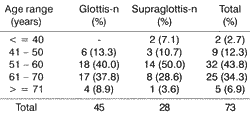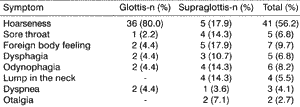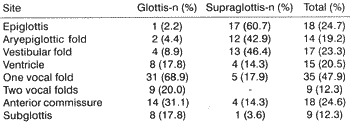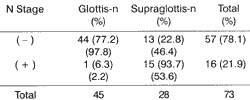

Year: 2001 Vol. 67 Ed. 4 - (15º)
Artigos Originais
Pages: 544 to 549
Clinical and Epidemiological Correlation of Initial Laryngea1 Squamous Cells Carcinoma (T1 anda, T2) - Study of 73 Cases.
Author(s):
Otávio A. Curioni*,
Marcos B. de Carvalho**,
Lincoln Miyahira***.
Keywords: carcinoma, larynx, epidemiology, symptoms
Abstract:
Introduction: Functional and structural modifications caused by laryngeal cancer are well established and recognized. However, mistakes in evaluating patient's larynx are not infrequent. The mistakes are a result of incorrect interpretation of signs and symptoms and lack of recognition of visible anatomical alterations. The literature review showed scarcity of studies that addressed the correlation of clinical and epidemiological information on laryngeal cancer; therefore, we decided to analyze and correlate clinical and epidemiological variables in order to better understand the natural history and forms of presentation of laryngeal cancer. Study design: Clinical retrospective. Method: A retrospective research based on the analysis of medical records of patients with initial squamous cells carcinoma of the larynx with no previous treatment, who were submitted to surgery at the Head and Neck Surgery Service of Hospital Heliópolis - São Paulo, between September/1977 and December/1997. Results: We found a predominance of glottic tumors in male patients in the sixth and seventh decades of life, smokers and alcohol abusers. For patients with supraglottic tumors, most of the symptoms were related to the digestive tract. As to macroscopic characteristics, glottic lesions were mainly vegetative, whereas in supraglottic lesions they were infiltrative. Conclusions: The clinical evolution of laryngeal cancer is the exact reproduction of the tumor progression in the affected region, manifesting distinct symptoms according to the lesion site. Therefore, the manifestations represent the morphological alterations caused in the organ.
![]()
INTRODUCTION
Diseases that affect the larynx share some common characteristics because they promote functional alterations corresponding to specific sites of affection, concerning the local anatomical and the role of laryngeal physiology. According to McDonald et al. (1976), if on the one hand most cases of laryngeal cancer are correctly clinically staged based on the extension of the mucosal lesion, on the other hand, relying exclusively on the mucosal invasion may depict only the tip of the iceberg, because of the potential hidden submucous dimension. This fact is especially true in supraglottic tumors, providing a potentially mistaken diagnosis and, consequently, inappropriate treatment. Clinical and epidemiological characterization of initial lesions may contribute to increase the number of diagnosed initial cases, improving the control rates of the disease because of the application of more focused therapeutic options. The study of local extension of laryngeal tumors, accompanied by the clinical manifestations, may help the understanding of its natural history, supporting the step-by-step correspondence between evolution of neoplasia and symptoms.
Taking into account the few studies addressing the interrelation of clinical-epidemiological data of laryngeal cancer, we decided to analyze some clinical, epidemiological and therapeutic variables and correlate them in order to contribute to the understanding of patterns of local-regional spread, natural history and different presentations of tumors.
MATERIAL AND METHOD
Based on a retrospective analysis of medical files, this study intended to correlate clinical-epidemiological characteristics of 73 patients with initial laryngeal squamous cell carcinoma (T1 and T2) treated at the Division of Head and Neck Surgery, Hospital Heliópolis/SP, between September 1977 and December 1997.
As to clinical and epidemiological data, we collected age, gender, smoking, alcohol abuse and clinical history We considered smokers all subjects who had a history of daily smoking of 10 cigarettes during their life span, whereas alcohol abuse was considered positive if there was history of daily intake of one dose of distilled alcoholic drinks, or equivalent, at some stage in life.
Clinical complaints were listed according to order of onset, differentiating first symptom from the constellation of symptoms at admission, according to laryngeal affected site. From the description of upper aerodigestive tract examination, we collected the findings concerning, in the following sequence, face and neck, anterior and posterior rhinoscopy, oral examination, indirect laryngoscopy and cervical palpation.
In order to characterize the anatomical site of the primary tumor, we divided the larynx into three regions: glottic, subglottic and supraglottis. The supraglottic sites comprised epiglottis, aryepiglottic folds, vestibular folds (or false vocal folds), arytenoids and ventricles; the glottic sites included the vocal folds and anterior and posterior commissures, and the subglottis, designated as a single site, was situated 1 cm below the free margins of the vocal folds, up to the inferior margin of the cricoid cartilage.
As to neck staging; we considered N- all cases with cervical clinical metastases (NO) and N+ as those with clinically detected metastases (Nl-3).
As to distant metastases, all cases were classified as M0, that is, none of them presented distant metastasis at admission, according to the investigation criteria that consisted of chest x-ray of asymptomatic patients.
If there were discrepancies between the initial preoperative registered data and those recorded in the transoperative period concerning primary site and extension of the lesion, we considered the data reported as surgical finding.
Descriptive statistical analysis (mean, median, standard deviation) were used for the variables age, alcohol abuse, smoking, symptomatology, macroscopy and T -N stages.
The association of variables was carried out with chi-square or Fisher's exact test, depending on the sample, with 95% significance level.
RESULTS
Distribution of patients according to site of primary lesion (glottic or supraglottic tumor) and age range is shown in Table 1.
Distribution of gender showed predominance of male over female patients, because only two patients were females (2.7%) and had supraglottic tumors. Only three male patients (4.1%) did not report history of smoking; two of them had glottic tumors and one had supraglottic tumor.
The duration of complaint, that is, the time from the onset of the first symptom to the first medical visit, ranged from less than one month to more than one year. Patients with glottic tumors, in average, had longer duration than supraglottic tumor patients - 6.9 and 5.5 months, respectively. The median for patients with glottic tumors was 5 months and for supraglottic tumors it was 4 months, which did not produce statistically significant differences (p=1.0).TABLE 1 - Distribution of patients according to age range and anatomical site of primary lesion.
p = 0.034
TABLE 2 - Distribution of patients according to alcohol abuse and anatomical site of primary lesion.
p = 0.350
TABLE 3 - Distribution of patients according to the first reported symptom and anatomical site of primary lesion.
TABLE 4 - Distribution of patients according to symptom that motivated the medical visit and anatomical site of primary lesion.
DISCUSSION
The incidence of laryngeal carcinoma in the extremes of age seems to be an exception, because there seem to be more concentration of affected subjects at advanced ages, regardless of gender. Our sample showed age range distribution similar to the reports in the literature, with a predominance of patients in the sixth and seventh decades of life. However, patients with supraglottic tumors were more concentrated in younger age ranges. This distribution may reveal the impact suffered by the supraglottic mucosa by carcinogenic agents, especially alcohol, because of its contact with the airways and digestive tract, leading to earlier manifestation.TABLE 5 - Distribution of patients according to macroscopy of the primary lesion by anatomical site.
p = 0.012
TABLE 6 - Distribution of patients according to sites affected by primary lesion by anatomical region.
TABLE 7 - Distribution of patients according to T staging and anatomical region.
p < 0.05
TABLE 8 - Distribution of patients according to regional spread by anatomical site.
p < 0.0501
Smoking and alcohol abuse are considered well-established risk factors for laryngeal cancer, a fact confirmed by our sample, in which only 4.1% of the patients were not smokers and 16.4% did not drink alcoholic beverages. We could not correlate presence of neoplasia and the effects of the doses of alcohol and smoking and the different anatomical sites (glottis and supraglottis). There are reports that suggested the existence of a synergic effect, especially in patients who were heavy drinkers and smokers (Stephenson et al., 1991; Muscat et al., 1992). This combined effect seemed to be more marked in supraglottic than glottic tumors.
The symptomatologic manifestation of laryngeal cancer in the initial stages is very mild, but not rare; if appropriately considered, we may find a laryngeal carcinoma at initial phase, when the possibilities of cure are extremely high. Dysphonia is the most marked symptom in laryngeal cancer, especially in cases of vocal fold tumor; in fact, it may be the first symptom, as described by 95.6% of the patients with glottic tumors. In the few cases in which hoarseness is not recognized, there may be throat symptoms that are not normally eye-catching or are considered difficult to describe.
In the supraglottis, the initial symptom was different: dysphonia amounted to 53.7% of the cases, followed by high digestive tract symptoms. The disagreement of symptoms between the regions is the result of the anatomical and functional differences between them. In cases in which dysphonia is not initially present, the neoplasic growth has generally affected regions that do not impact mobility or shape of vocal folds, which is normally an epiglottic tumor. Unless there is a well successful intervention or a fatal concurrent disease, hoarseness will be present in all cases, either initially or later.
Although symptomatology of the initial laryngeal neoplasic disease is predictable, the diversity of symptoms reported at the moment of diagnosis seems to be representative of the extension of the lesion into the neighboring areas of the primary tumor. These data should be valued since therapeutic approach is based on them.
The time of evolution was investigated in an attempt to correlate initial lesion, both local and regional, to longer duration, which could indicate a slow growing lesion, more favorable to the patient. However, there is an array of studies evidencing the difficulty to define this time, since it is a subjective piece of information that depends on the patients' memory (Eiband et al., 1989; Trigg et al., 2000). In the present study, the duration of the complaint varied from one to 12 months. In average, patients with glottic tumors had longer duration than those with supraglottic tumors - 6.9 and 5.5 months, respectively, a non-significant statistical difference.
Hoarseness is the only manifestation of organic abnormality in the larynx of patients with glottic tumors for some time until the disease is extended into other sites that may produce other symptoms. In addition, vocal pattern modification is a frequent symptom among people. Especially for smokers and alcohol abusers, who tend to have irritative or upper airway laryngitis of spontaneous resolution. Thus, subjects may delay the visit to a physician because of symptoms that they believe to be temporary.
Conversely, pain is one of the most feared manifestations of people. As supraglottic manifestations normally include this symptom, there seem to be a natural trend for patients to search for medical help earlier, a fact confirmed by the present study.
It seems clear that the first functional laryngeal disorders of cancer are so insignificant and benign that its onset tends to be overlook. Moreover, patients are not aware of the possible nature of the problem, access to medical services is not readily available and sometimes the physician may not immediately identity the pathology.
Macroscopic characteristics of the primary lesion are considered in the preoperative assessment, because it is believed that vegetating lesions are worse than infiltrative lesions as far as prognosis goes (Kirchner and Som, 1971; Eiband et al., 1989; Scwartz, 1999).
As to distribution of sites in the larynx, we noticed more vegetating lesions in the glottis, as opposed to more infiltrative lesions in the supraglottis. These results were different from those reported by McGavran (1961); McDonald et al. (1976) and Schwartz (1999).
It is important to know the growth pattern in different laryngeal regions because a lesion classified as endolaryngeal or initial, may turn out to be something different. For example, an epiglottic lesion that thanks to the infiltrative growth reached the pre-epiglottic space, showing a more advanced lesion; all these data are relevant for therapeutic planning.
Discussion of laryngeal cancer with no definition of the exact primary lesion may mislead us to inappropriate staging and therapeutic approach, especially in initial lesions, for which there is effective oncologic treatment, preserving laryngeal voice. The tumor origin site influences not only symptomatology, but also histopathology and clinical behavior of the carcinoma. In the present series, we observed that 28 out of 45 primary tumors of glottis were confined to the vocal folds at the time of treatment. Vertical extension to subglottis was found in 8 cases (17.8%), and to supraglottis in 9 cases (20.0%). The opposite laryngeal side was invaded in 9 cases (Table 6). Supraglottic tumors presented extensions into the glottis in 9 cases. This distribution justifies the varied symptomatology of laryngeal cancer patients.
CONCLUSIONS
Our findings confirmed the higher incidence of laryngeal squamous cell carcinoma in male subjects, smokers, aged between the sixth and seventh decades of life. However, for the supraglottis, the association with alcohol abuse seemed to anticipate the manifestation of the disease.
Clinical manifestations of laryngeal squamous cell carcinoma represent well the morphological alterations caused in the organ. Its natural evolution is a reliable reproduction of the tumor progression in the affected region, presenting different symptoms according to the affected laryngeal site. In the glottis, there is usually dysphonia (hoarseness), whereas supraglottic symptoms are predominantly painful and related to the high digestive tract.
REFERENCES
EIBAND, J. D.; ELIAS, E. G.; SUTER, C. M.; GRAY, W C.; DIDOLKAR, M.S. - Prognostic factors in squamous cell carcinoma of the larynx. Am. J. Surg., 158: 314-17, 1989.
KIRCHNER, J. A.; SOM, M. L. - Clinical and histological observations on supraglottic cancer. Ann. Otol. Rhinol. Laryngol., 80: 638-45, 1971.
McDONALD, T. J.; DE SANTO, L. W; WEILAND, L. H. Supraglottic larynx and its pathology as studied by whole laryngeal sections. Laryngoscope, 86: 635-48, 1976.
McGAVRAN, M. H.; BAUER, W C.; OGURA, J. H. - The incidence of cervical lymph node metastases from epidermoid carcinoma of the larynx and their relationship to certain characteristics of the primary tumor. Cancer, 14: 55-66, 1961.
MUSCAT, J. E.; WYNDER, E. L. - Tobacco, alcohol, asbestos and occupational risk factors for laryngeal cancer. Cancer, 69: 2244-51, 1992.
SCHWARTZ, M. R. - Pathological of Laryngeal Tumors. In: Comprehensive Management of Head and Neck Tumors, Philadelphia, W B. Saunders Company, 1999, 950-78.
STEPHENSON, W T.; BARNES, D. E.; HOLMES, F. F.; NORRIS, C. W - Gender influences subsite of origin of laryngeal carcinoma. Arch. Otolaryngol. Head Neck Surg., 117: 774-78, 1991.
TRIGG, D. J.; LAIT, M.; WENIG, B. L. - Influence of tobacco and alcohol on the stage of laryngeal cancer at diagnosis. Laryngoscope, 110: 408-11, 2000.
* Master in Head and Neck Surgery.
** Head of the Division of Head and Neck Surgery, Complexo Hospitalar Heliópolis.
*** Resident in Head and Neck Surgery.
Study conducted at the Division of Head and Neck Surgery, Complexo Hospitalar Heliópolis, São Paulo.
Address correspondence to: Avenida Santa Ines, 190-Apto 101 - Santana - 02415-000 São Paulo/SP-Tel: (55 11) 6976-3028. E-mail: sccphh@heliopolis.org.br
Article submitted on January 15, 2001. Article accepted on March 19, 2001.







